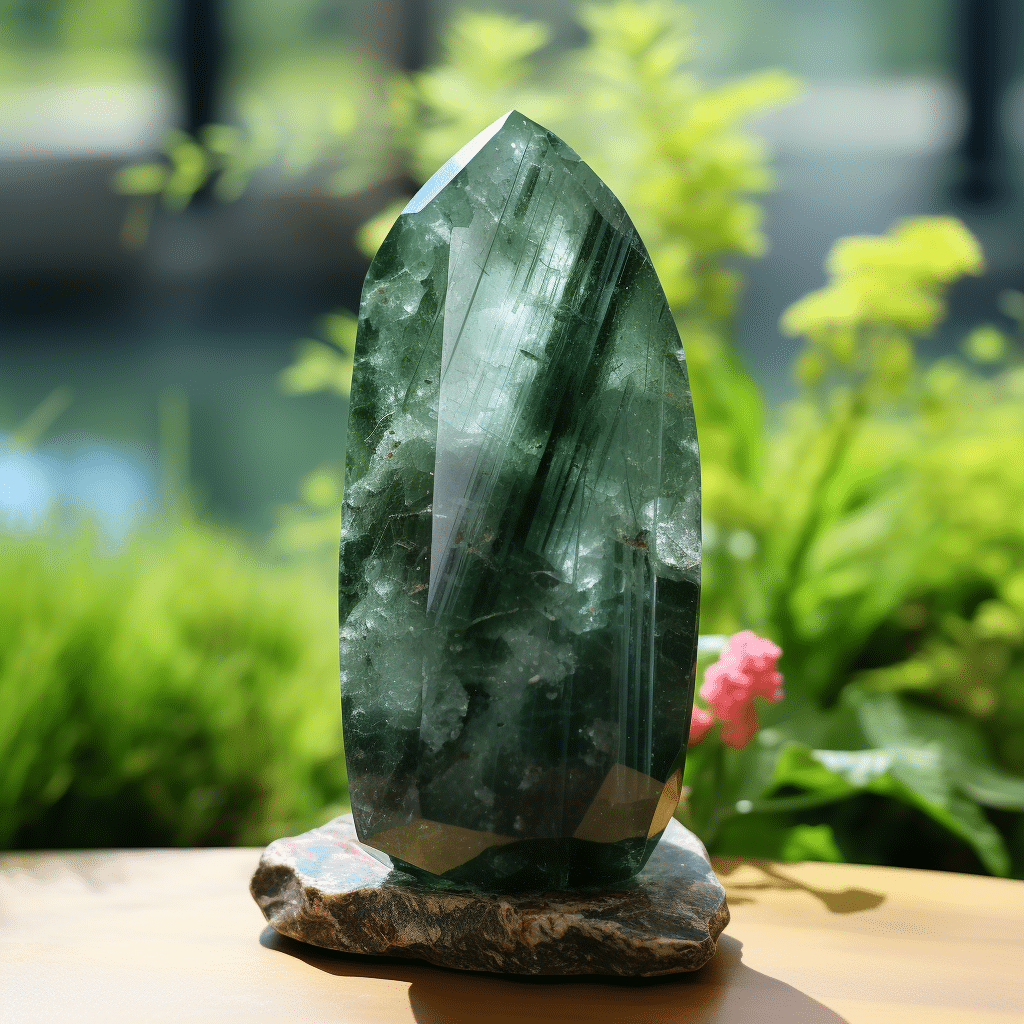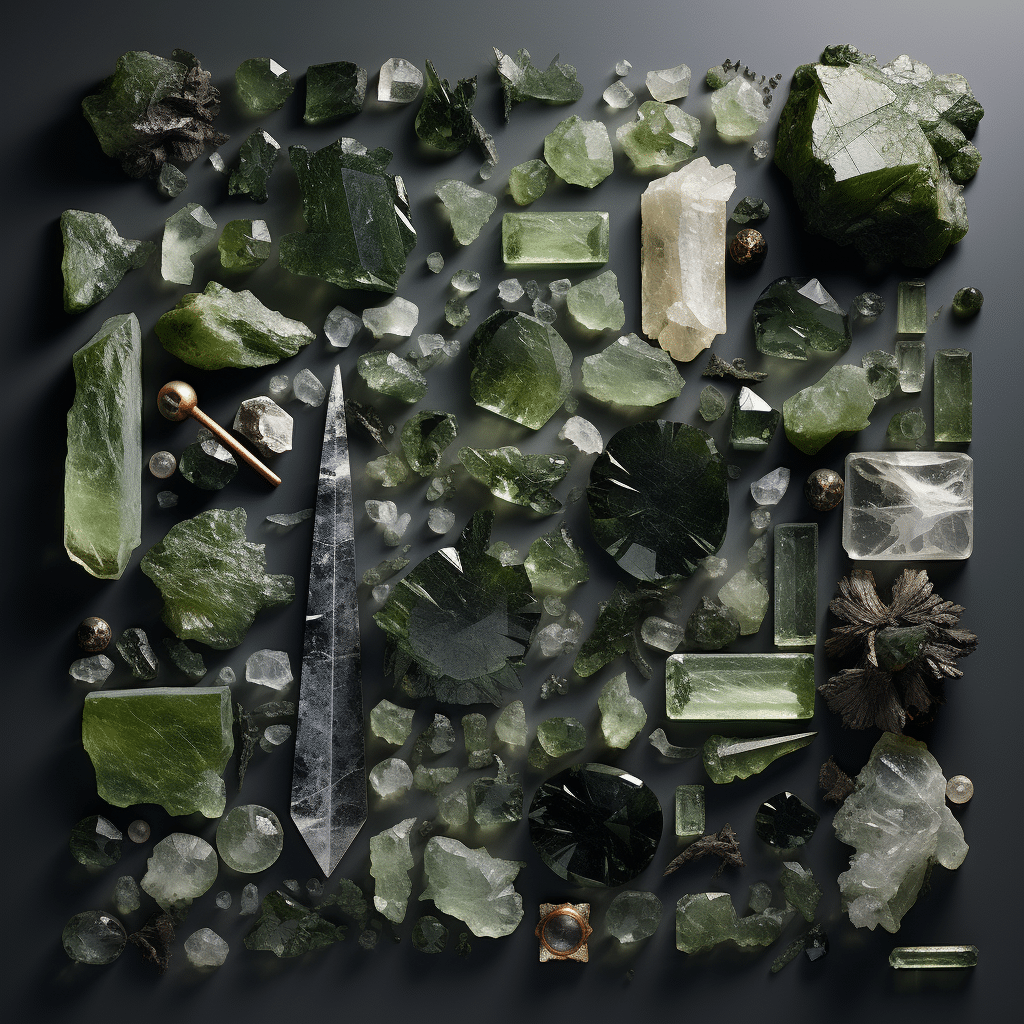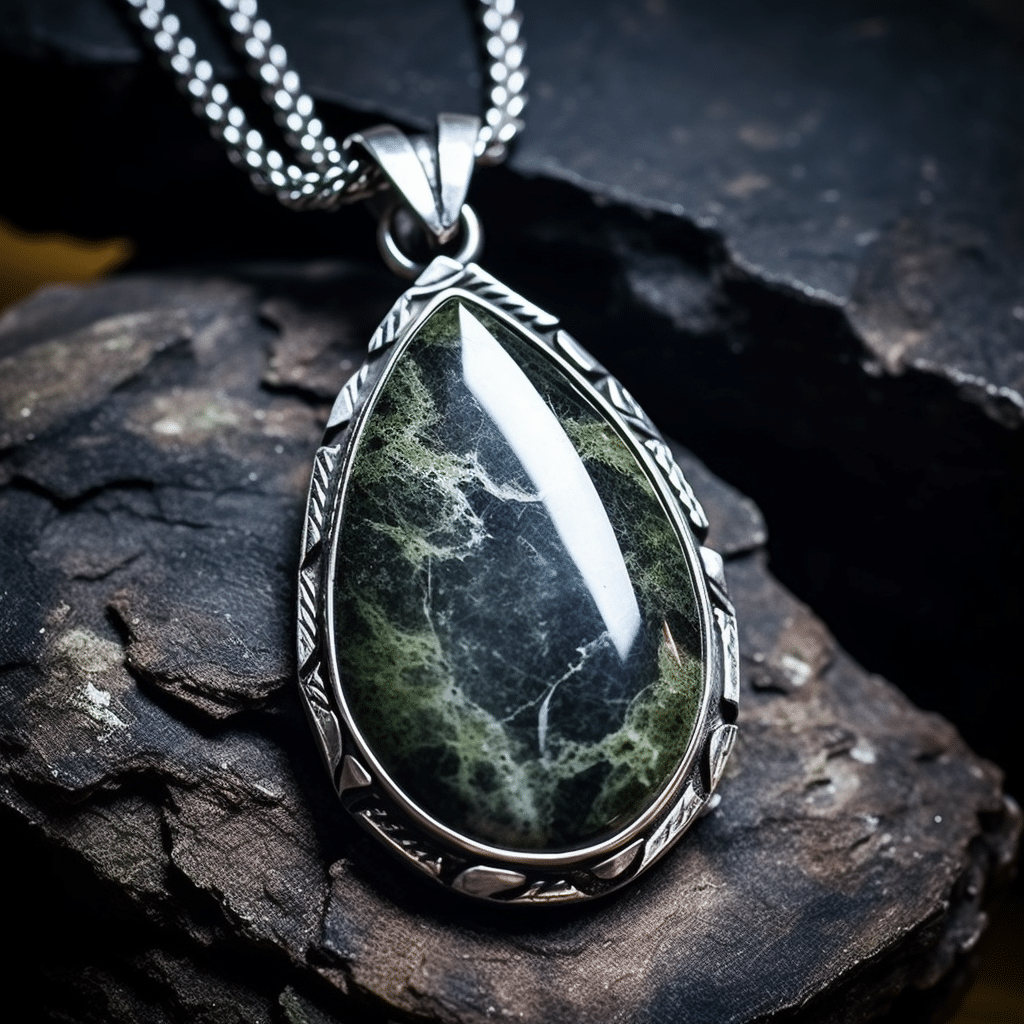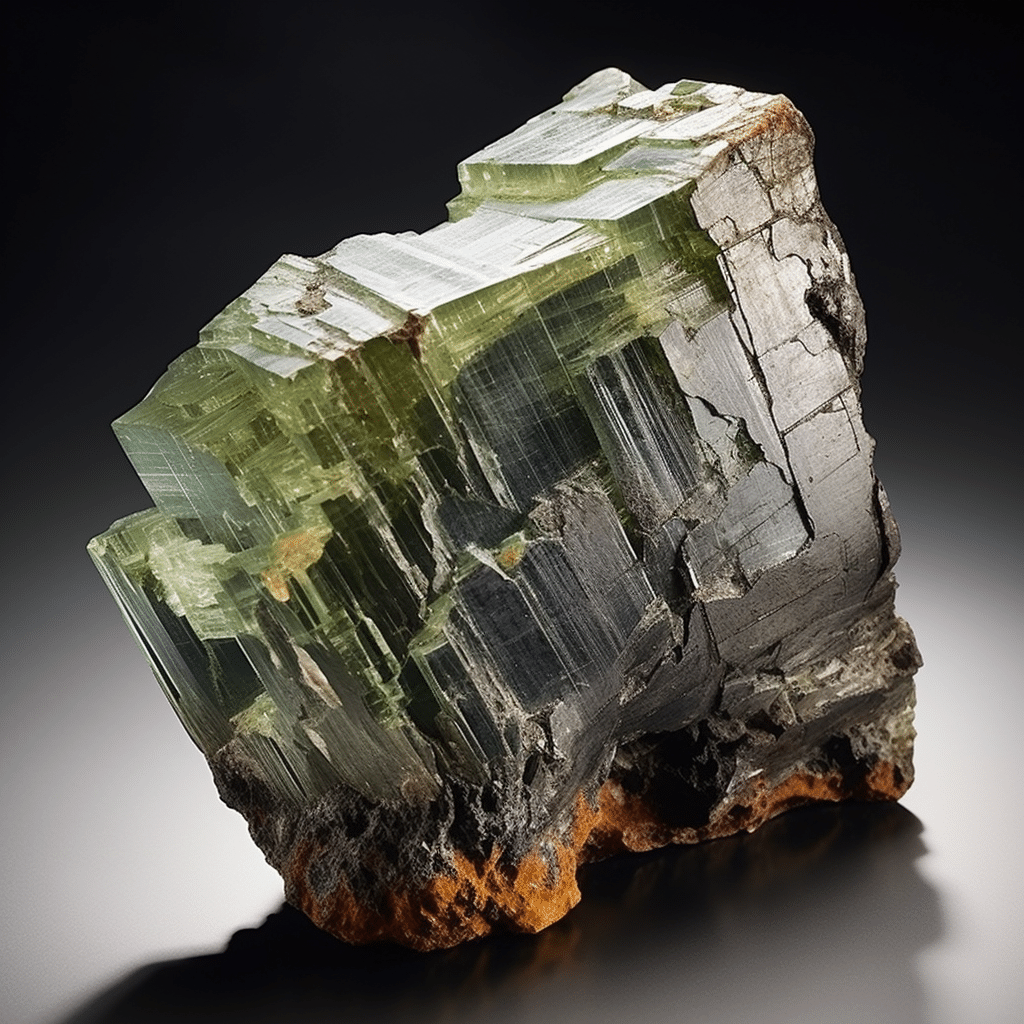Last Updated on October 11, 2023 by admin
Actinolite, a captivating gemstone, beckons attention with its unique dark green hue, intriguing texture, and myriad properties. Often found in various shades ranging from pale green to dark green, this mineral possesses an allure that transcends aesthetics. Historically, multiple cultures have revered Actinolite for its perceived healing properties and distinctive characteristics. But the narrative around Actinolite doesn’t just revolve around its beauty and healing potential; its relationship with asbestos, specifically actinolite asbestos, is equally noteworthy.
Geological Properties of Actinolite

Actinolite, primarily a member of the amphibole mineral group, boasts a unique chemical composition. Its chemical formula is often represented as Ca2(Mg, Fe)5Si8O22(OH)2. This complex formula indicates the presence of essential elements like calcium, magnesium, and iron. The balance between magnesium (Mg) and iron (Fe) gives Actinolite its remarkable green hue, which can vary from transparent Actinolite with a light shade to opaque varieties exuding a deeper dark green.
This mineral forms in a monoclinic crystal system. Its fibrous texture further distinguishes the physical properties of Actinolite. When magnesium-rich conditions prevail, especially in ultramafic rocks and magnesium-rich limestones, actinolite forms in thin fibers, often creating rare forms of this gemstone.
Actinolite’s allure isn’t just about its appearance. Its formation process, often a result of the alteration of other minerals, particularly in regionally metamorphosed rocks, makes it a mineralogical wonder.
Actinolite and Asbestos: A Deeper Look

The association between Actinolite and asbestos is pivotal in understanding this mineral’s broader implications. Asbestos is a term used to describe a group of naturally occurring fibrous minerals, and Actinolite is one of the six recognized types of asbestos. Specifically, actinolite asbestos is a form of amphibole asbestos, which also includes minerals like tremolite, crocidolite (blue asbestos), and amosite (brown asbestos).
While asbestos has had various industrial applications, including its use in brake pads, insulation, floor tiles, and roofing products, it has been a source of concern for health professionals worldwide. Asbestos exposure, especially prolonged occupational exposure experienced by asbestos workers, can lead to severe health complications. From lung cancer to mesothelioma and asbestosis, the implications are alarming.
Actinolite asbestos and other related amphibole asbestos varieties, such as tremolite asbestos and chrysotile asbestos (white asbestos), are distinguishable by their thin, fibrous crystals. These fibers, when inhaled, can get lodged in the lungs, causing significant health issues. A surge in cases related to lung cancer and other ailments among construction workers, especially those dealing with asbestos-containing materials, led to strict regulations and, in some countries, a total ban on asbestos use.
While not all Actinolite contains asbestos fibers, it’s crucial to differentiate between the fibrous Actinolite, which holds the potential for asbestos exposure, and the non-fibrous forms that are sought after for their aesthetic and healing properties.
Amphibole Minerals and Their Composition: Understanding Actinolite, Tremolite, and Calcium Silicate Minerals.
Actinolite is one of the intriguing members of the amphibole mineral group. This group, broadly characterized by its double-chain silicate structure, has several members that share similarities yet possess distinct characteristics. Actinolite, notably, is recognized for its rich green color, which can range from pale to deep shades. The composition of Actinolite is fundamentally based on calcium, making it a calcium silicate mineral. Another closely related amphibole is Tremolite. While similar in many ways to Actinolite, the absence of iron in Tremolite distinguishes the two.
The Asbestos Family: Distinguishing Amosite and Crocidolite Asbestos from Only Chrysotile Variants.
When discussing asbestos, it’s vital to understand its diverse types. Asbestos isn’t just one mineral; it’s a family of silicate minerals with fibrous properties. Amosite, often termed “brown asbestos,” and Crocidolite, or “blue asbestos,” belong to the amphibole group of asbestos. They are both known for their elongated fibrous crystal habits and their adverse health implications when inhaled.
Chrysotile, in contrast, stands apart as the only member of the serpentine group within the asbestos family. Often called “white asbestos,” Chrysotile’s fibers are curly and more flexible than its amphibole counterparts. While Chrysotile’s risks have been debated, all forms of asbestos are recognized as health hazards.
Occupational Exposures to Actinolite: Risks of Mesothelioma and Impacts on Those Exposed.
One of the significant concerns regarding Actinolite and other amphibole asbestos minerals is the risk of occupational exposure. Workers in industries dealing with asbestos-containing materials, notably construction, shipbuilding, and mining, may unknowingly come into contact with Actinolite fibers. Prolonged inhalation of these fibers is linked to several respiratory diseases, the most severe being mesothelioma—a rare and aggressive cancer primarily affecting the lining of the lungs. It’s crucial for industries to recognize these risks and implement rigorous safety standards to protect their workforce.
Occurrences and Differences: Comparing Chrysotile with Actinolite in Natural Formations.
In the natural world, both Chrysotile and Actinolite can be found in metamorphic rocks. Their occurrence is due to the alteration of precursor minerals under specific heat and pressure conditions. While both minerals are fibrous, their structures, as mentioned, differ significantly. Chrysotile, with its serpentine origin, has a layered, curly fiber structure, whereas Actinolite, an amphibole, has a more rigid, straight fiber configuration. Understanding these distinctions is pivotal, especially when evaluating asbestos sources and implementing removal or containment strategies.
The Unique Composition of Actinolite Crystal
Actinolite crystal is an intriguing mineral, primarily composed of calcium-magnesium. This specific composition gives it a unique color palette, ranging from a vivid yellow-green to a subtle grayish green. Interestingly, the mineral’s color intensity and hue can vary depending on its exact chemical makeup. The presence of more magnesium typically results in a deeper green shade akin to that of green actinolite, a popular variant of the crystal.
Moreover, this crystal is often found in magnesium-rich limestones, formed under high pressure and temperature conditions. This formation process is typical in regionally metamorphosed rocks, where the crystal’s needle-like structure is most commonly observed.
Actinolite Crystal and Its Metaphysical Properties
Actinolite crystal is not only valued for its unique physical properties but also for its metaphysical attributes. The crystal is believed to ward off negative energies, making it popular among those interested in crystal healing and energy work. With its vibrant hue, the green actinolite is especially associated with rejuvenation and renewal.
The cat’s eye actinolite, another variant of this crystal, is renowned in the gemstone market for its unique visual effect. When cut and polished correctly, this crystal exhibits a striking ‘cat’s eye’ phenomenon, a unique refractive index property that gives the stone a luminous streak of light, much like the slit eye of a cat.
However, it’s essential to note that some forms of this mineral, specifically actinolite asbestos, have been linked to health concerns. As such, proper handling and care should be exercised when dealing with this variant of the crystal.
Healing Properties of Actinolite

Beyond its geological fascination, Actinolite has been revered for its myriad healing attributes. Many have believed in its potent abilities to benefit the body, mind, and spirit for centuries.
Physical Benefits:
Actinolite’s physical benefits are both tangible and subtle. In the realm of crystal healing, it’s said to bolster the immune system. Some holistic practitioners believe it to be beneficial for those recovering from illnesses, suggesting it may assist the body in its natural healing processes. While direct scientific evidence might be lacking in terms of these claims, the placebo effect and the power of belief cannot be understated.

Mental and Emotional Benefits:
Mentally, Actinolite is lauded for its ability to clarify thoughts and improve cognitive function. It’s believed to sharpen the mind, aiding concentration and focus. Emotionally, Actinolite is seen as a stabilizer. The dark green hue of the stone is often associated with balance and harmony. Promoting emotional well-being helps one navigate emotional upheavals and bestows a sense of calm amidst the chaos.
Spiritual Benefits:
The power of Actinolite extends to the spiritual realm as well. Many crystal enthusiasts and spiritual practitioners regard Actinolite as a tool for grounding. Aligning one’s energies it’s thought to foster a deep connection between the individual and the Earth, allowing for spiritual anchoring.
Metaphysical Properties and Spiritual Significance

In the metaphysical world, Actinolite’s importance is undisputed. Its dark green color resonates with the heart chakra, which is the energy center associated with love, compassion, and emotional balance. When the heart chakra is open and aligned, it paves the way for unconditional love, not just for others but for oneself as well.
Actinolite, in this context, is seen as a facilitator for this alignment. By placing the stone on the heart during meditation, practitioners believe it aids in releasing emotional blockages, healing past wounds, and fostering a sense of universal love.
Furthermore, Actinolite can be a powerful tool for those on a spiritual journey. It’s thought to heighten intuition, making it an excellent stone for those looking to deepen their meditation practices or tap into their psychic abilities.

This mineral’s metaphysical properties are also linked to manifestation. By clarifying intent and removing energetic blockages, actinolite aids in transforming thoughts into reality. Many spiritualists use this stone when setting intentions or during manifestation rituals, trusting in its power to amplify their desires and bring them to fruition.
Practical Uses of Actinolite
From the past to the present, Actinolite’s unique aesthetic and believed healing properties have made it a favorite for various applications. Here, we journey through some of its most popular uses.
Actinolite in Jewelry:
Actinolite’s deep and alluring dark green hue makes it a sought-after gem for jewelry creation. Its versatility allows it to be crafted into various forms – from stunning pendants that grace the neck to elegant rings and bracelets. When polished, the magnesium-rich mineral exudes a lustrous shine, making it a favorite among jewelry designers and enthusiasts.

Beyond aesthetics, wearers often choose actinolite jewelry for its aforementioned healing properties, seeking both beauty and holistic benefits.
Actinolite in Home Décor:
While Actinolite’s primary source may be in jewelry, it’s also gaining traction in home décor. Whether in the form of polished stones placed decoratively in living spaces or incorporated into wall designs, the stone adds a touch of nature-inspired beauty to interiors. Its deep green shades offer a soothing ambiance, making it a favorite for spaces dedicated to relaxation and meditation.

Furthermore, for those who believe in crystals’ spiritual and metaphysical properties, placing Actinolite in homes is thought to cleanse the environment of negative energies, ensuring a harmonious living space.
Actinolite in Rituals:
Given its rich spiritual significance, Actinolite finds its place in various rituals across cultures. Its revered status is clear, from being used in ceremonies to purify spaces to being an integral part of manifestation rituals.

Cleaning, Charging, and Caring for Actinolite
Ensuring your Actinolite remains in its optimal state is crucial. Whether you’re harnessing its healing energy, wearing it as jewelry, or simply admiring its beauty, proper care is a must.
Cleaning Actinolite:
Regularly cleaning Actinolite ensures it remains free from dirt and maintains its natural luster. However, care must be taken due to its fibrous nature and its links to asbestos.
- Avoid using harsh chemicals. Instead, use a soft cloth dampened with lukewarm water.
- Gently wipe the Actinolite, ensuring it does not scratch its surface.
- Let it air dry, or use a soft towel to pat it dry.

Charging Actinolite:
To rejuvenate its energies, Actinolite can be charged. The most common method is by moonlight. Placing the stone under the moon, especially during a full moon, is believed to imbue it with rejuvenated energies.

Storing and Caring:
When not in use, Actinolite should be stored away from direct sunlight and other minerals to prevent it from losing its color and to avoid scratches. Using a soft pouch or a fabric-lined jewelry box is ideal.

Actinolite: A Historical Perspective
The journey of Actinolite is as varied as its forms. As a magnesium-rich mineral, its dark green allure has captivated humanity for centuries. The name “actinolite” is derived from the Greek word ‘aktinos,’ meaning ‘ray,’ referring to the mineral’s fibrous nature.
Ancient Civilizations:
Historical records hint at the use of Actinolite by ancient civilizations. Its magnificent green hue made it an emblem of nature, fertility, and growth. It was not uncommon to find actinolite beads in the jewelry of royalty, symbolizing prosperity and divine connection.
However, it wasn’t just the beauty of Actinolite that caught the attention of our ancestors. Its connection to asbestos and its fibrous nature made it valuable in construction and industrial applications. The resilience of asbestos-containing materials like Actinolite made them a primary choice for insulation and fireproofing in ancient structures.
The Middle Ages:
Fast forward to the Middle Ages, Actinolite, especially the rare forms, began to be associated with mystical properties. Healers and alchemists believed in its power to cleanse the spirit and connect the human soul to the earth.
The Industrial Age:
The discovery of Actinolite’s properties linked to asbestos changed its trajectory. As industries boomed, the demand for asbestos materials, including actinolite asbestos, surged. Construction workers, asbestos workers, and others began incorporating this fibrous mineral in roofing products, brake pads, and clutch facings.
However, this boom came at a price. Occupational exposure to asbestos dust led to alarming health concerns. Asbestos workers began to show signs of lung cancer and mesothelioma, diseases directly linked to asbestos exposure. Consequently, by the late 20th century, many countries began re-evaluating their stance on asbestos use, and Actinolite came under scrutiny due to its actinolite asbestos variant.

The Asbestos Controversy
Actinolite’s association with asbestos has been a point of contention for decades. In its fibrous form, the mineral is one of the six recognized types of asbestos. While its unique properties made it indispensable in various industrial applications, the health risks associated with it became increasingly evident.
Health Implications:
Numerous studies have linked prolonged asbestos exposure to severe health issues. Asbestos fibers, when inhaled, can lead to lung cancer, asbestosis, and the aggressive cancer known as mesothelioma. Asbestos workers, especially those involved in mining and processing actinolite asbestos, became the primary victims.

The thin fibers of actinolite asbestos can quickly become airborne. Once inhaled, these fibers get trapped in the respiratory system, leading to inflammation and scarring. Over time, this can result in breathing complications and increase cancer risk.
Legal and Industrial Repercussions:
Given the dire health implications, many countries initiated strict regulations on asbestos use, leading to a total ban in several member states. Industries that heavily relied on asbestos-containing materials, including actinolite asbestos, had to seek alternatives.
While the use of asbestos, including actinolite asbestos, has declined significantly over the past few decades, the legacy of its use continues to affect many. Buildings constructed using asbestos materials, brake linings in older vehicles containing Actinolite, and contaminated talc are just a few examples of its lingering presence.

Actinolite Today: A Gem Beyond Controversy
Despite its controversial past, Actinolite, especially the transparent actinolite variant, is cherished today for its metaphysical and healing properties. When sourced and used responsibly, the mineral can be a beautiful and beneficial addition to one’s collection.
Its dark green and pale green hues resonate with nature lovers, while its supposed spiritual benefits continue to attract those on a journey of self-discovery and wellness.

Frequently Asked Questions about Actinolite

1. What is Actinolite used for?
Actinolite has been utilized for numerous purposes throughout history. In ancient times, its vibrant green hues were fashioned into beads and jewelry. However, its fibrous nature and connection to asbestos also found substantial use in industrial applications. Actinolite asbestos was used in construction, brake pads, and insulation. Today, transparent Actinolite and other non-fibrous forms of the mineral are coveted for their metaphysical properties and are often incorporated into jewelry, healing rituals, and spiritual practices.

2. What is the benefit of actinolite crystals?
Beyond its aesthetic appeal, actinolite crystals are believed to offer several metaphysical and healing properties. Many claim that the mineral aids in balancing the body’s energies, supports the immune system, and enhances cognitive functions. On an emotional level, Actinolite is said to promote feelings of well-being, reduce stress, and encourage spiritual growth.
3. How rare is Actinolite?
Actinolite, in its common dark green form, is relatively widespread. However, specific variants, particularly transparent Actinolite and rare forms with unique crystal structures or colors, can be harder to find and, thus, are more valuable. Certain types of Actinolite rarity depend on factors like location, quality, and the presence of other minerals.

4. What is the spiritual meaning of Actinolite?
Actinolite is revered as a stone of balance and harmony in metaphysical circles. It is believed to connect the physical and spiritual realms, assisting individuals in grounding themselves while exploring higher states of consciousness. The mineral’s green hues are said to resonate with the heart chakra, promoting love, compassion, and spiritual growth. Additionally, Actinolite is thought to act as a shield, protecting its bearer from negative energies and psychic attacks.

Conclusion

Actinolite, a captivating gemstone with its mesmerizing dark green to pale green shades, offers more than just visual allure. From its intricate chemical composition and physical properties to its purported healing abilities and metaphysical significance, Actinolite captures the essence of the marvels our Earth conceals beneath its surface.
Its rich history, intertwined with both beauty and industrial applications, serves as a testament to its multifaceted nature. But as with all things, understanding its deeper associations, especially with asbestos, underscores the importance of awareness and careful handling in certain contexts.
For those drawn to the spiritual and healing realms, Actinolite promises a journey of balance, protection, and growth. As with all minerals and crystals, the bond one feels with Actinolite is deeply personal, and its benefits are best experienced firsthand.
Whether you’re a geology enthusiast, a spiritual seeker, or simply an admirer of nature’s artistry, Actinolite invites you to delve deeper, explore its mysteries, and perhaps find a bit of its magic within yourself.




